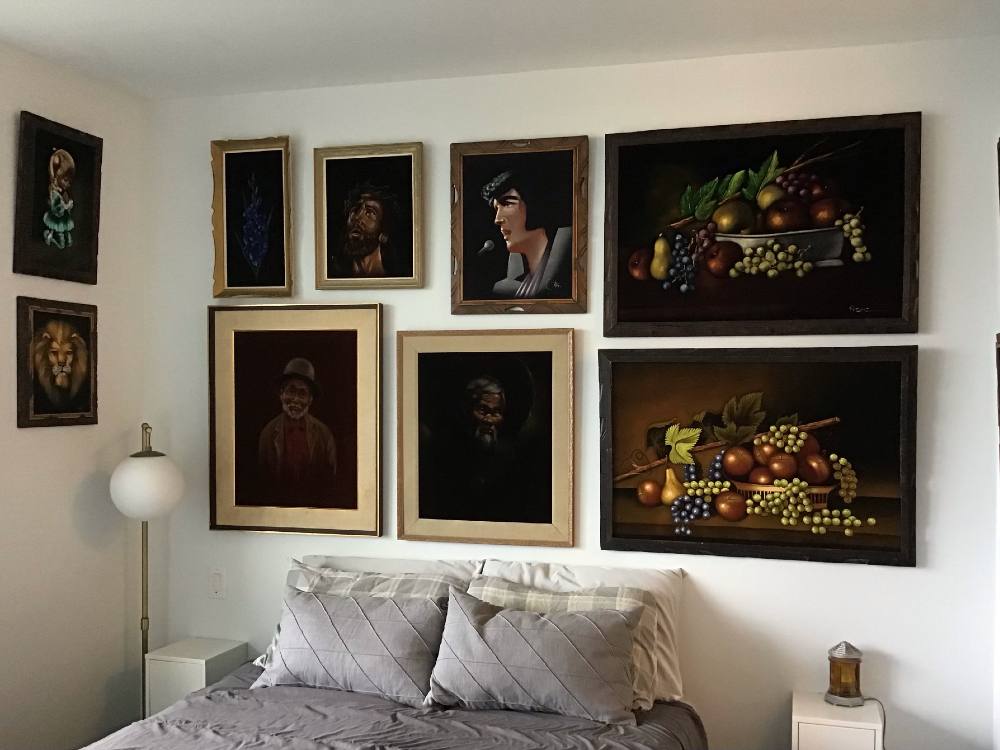[Editor’s note: This excerpt forms part of our spotlight on B.C.’s literary magazines. Today, we republish a piece by Robyn Ludwig, originally published in Geist magazine. Based in Vancouver and founded in 1990, Geist is a quarterly magazine, now edited by Tanvi Bhatia, that focuses on ideas and culture in in the form of essays, photography, comics, poetry and reviews. 'What I like about the piece is that it digs into one of the weird, forgotten aspects of Canadian art history,' Bhatia says.]
The phrase “velvet painting” brings to mind crying clowns and softcore tropical nudes, stacked unceremoniously in thrift shops or flea markets. Among these you’re unlikely to find a valuable Edgar Leeteg, the only velvet artist to achieve any degree of name recognition; but you may happen upon a neglected gem by one of four Canadian women — Minn Sjolseth-Carter, Dorothy Francis, May Clarke, Joy Caros — who painted prolifically, pragmatically and obscurely, on velvet.
In my early 20s, I received my first piece of velvet art, a hideous, enormous still life of a bowl of fruit, purchased at Value Village by a friend as a gag gift for my birthday. Over the next two decades I’ve acquired three dozen velvet paintings, including a “Velvis” that I religiously lint brush, an unsigned, slightly crooked, crown-of-thorns Jesus haggled from a Winnipeg antiques shop, and a narrow assemblage of blue flowers on black velvet, with a typewritten inscription on pink card stock: “VI Waddington, Winnipeg.”
A search revealed the artist as Viola Clara Martha Waddington (1916–2003), whose obituary referred to unspecified “creative talents.” I feel object empathy for the paint-by-numbers kit paintings made by women artists like Waddington, a feeling as irrational as my affection for unattributed velvet paintings made in assembly-line factories. I rescue their velvety floral arrangements, consigned, as the unwanted craft projects of amateurs and hobbyists, to online classifieds, cobwebbed attics, garage sales. Or worse, to landfills. I trace the origins of my velvet hoarding tendencies to a fire that gutted my family home when I was 12. I learned that the only safe attachment to possessions comes with things that are cheap, laughable, easily replaced.
In 2018, I purchased, through Kijiji, a velvet portrait of an elderly Asian man, signed “Min Sjolseth” [sic] and entitled “Sommy Bing.” I discovered that Minn Sjolseth-Carter (1919–1995) was a Norwegian-born artist who settled in Vancouver in 1957 and opened the Minn-Tonge gallery, downtown on Pender Street. There she produced oil-on-black-velvet portraits of Asian and Polynesian men, women and children, in sufficient quantities to still appear regularly on auction sites. I got in touch with her daughter, the visual artist Laila Campbell, who stated bluntly in an email, “Somehow these works were very popular then.” Sjolseth-Carter closed the gallery in 1967, quitting velvet and committing herself exclusively to other media. After her death, much of her substantial body of work was accessioned by museums and galleries, but not one of her velvets.
In March 2020 I spotted a Dorothy Francis (1923–2016) painting on Craigslist and drove out to New Westminster to meet the owner. I parked illegally in the cul-de-sac of a highrise condo development. Wearing surgical gloves and a cloth mask, I handed $25 to an older gentleman, who wore a mask but no gloves. He handed me a 20" x 27" portrait of an elderly Asian man brushed into soft brown velvet, an offensively hackneyed piece that I was both excited and ashamed to get my hands on. The seller seemed relieved that the painting had found an appreciative buyer. At home, I emailed Francis’s son, the visual artist Tim Francis, who wrote, “Part of mom’s motivation to paint on velvet was doing portraits because she thought they could be compelling. The other part was likely financial. With five young children I know my father pushed her to produce work that would sell.” Five years after her death, Francis remains only known for her watercolours, pastels and acrylics on paper and canvas.
In late March 2020, unemployed and bored as a result of the pandemic, I decided to track down Joy Caros (b. 1932), the indisputable queen of velvet painting. Over the phone, Caros was formidable. With little sentimentality she described her early years as an artist in Vancouver. She experimented first with difficult-to-handle chalk on velvet. She plied her trade painting portraits for tourists in Stanley Park, and for customers at Trader Vic’s Polynesian-themed restaurant in Coal Harbour. Vancouver’s Jewish community provided her a stable source of lucrative commissions throughout the 1950s. What changed the course of her career was a tour of Hawaii, and an invitation to visit the gallery of the art dealer Barney Davis. Davis represented Leeteg, whom he marketed as the “Gauguin of American velvet painting.” He hired Caros to surreptitiously retouch Leeteg paintings for sale. Also in Hawaii, while exhibiting her velvets at the Hilton Hawaiian Village hotel, Caros had a chance meeting with the director Stanley Kramer. He commissioned a dozen portraits of the cast of his 1963 film It’s a Mad, Mad, Mad, Mad World, flying her out to Hollywood.
Back home in 1964, Caros painted the Beatles on velvet. She offered the painting to the local DJ Red Robinson in exchange for front-row seats to the Beatles’ only concert in Vancouver. Later that year, Caros took her velvet paintings on a cross-country tour of the Canadian Pacific Railway grand hotels and sold out by the time she left Toronto for Montreal.
Caros left Canada and spent more than thirty years in Italy. Abroad she marketed her trademark velvet iconography: water and tear droplets on Polynesian women and children. She continued to pursue sales through exhibits at hotels in Europe and North America. In the late 1990s, she left behind velvet as a canvas. Family portraits commissioned by the visually impaired singer Andrea Bocelli were her last velvet works.
During our conversation, Caros said Europeans respect velvet more than Americans do. She lamented “commercial junk” reproductions and forgeries that devalued her work, and she spoke with exasperation about efforts to defend the copyright to her images. Yet she also talked animatedly about licensing her work for pillowcases and candy wrappers. She said, “I don’t miss velvet. There is no market for it. I don’t think about it.”
Caros came across as dismissive of her velvet work, but fiercely proud of her technique. Able to produce one painting a week, Caros would stretch velvet over hardboard, sketch an outline with chalk or pastel and dry-brush oil paint with pig-hair brushes. A technique, she boasted, “few artists can manage.” A visitor to one of her shows in Italy, she said, had snipped off a piece of the fabric, believing that “the secret was in the velvet.”
In April 2020, I stumbled upon the work of the velvet artist May Clarke (date of birth and death unknown) of Ontario. A slight biography on the Historical Peel Artists website said that Clarke became a “professional artist” in 1964 due to “public demand” for her oils on black velvet and that “as fast as she completed a picture on velvet, a buyer would purchase it from her.”
I was able to locate one original May Clarke, acquired by a woman in Ontario from a thrift store: a portrait of a sultry, exoticized woman, with a blank expression, hooded in lace. It was a technically competent, if unoriginal, composition that evoked the uncanny valley, as unnerving as the big eyes of a Margaret Keane painting, whose work recently experienced a resurgence after Tim Burton made a biopic about her called Big Eyes. Even a fan such as myself has to acknowledge velvet paintings as aesthetically disturbing and problematic as artifacts of appropriation and cringeworthy stereotypes.
A few weeks after our phone interview, I accepted an invitation to meet with Caros, who is in her 80s, at her New Westminster apartment. The walls were decorated salon-style with her oil-on-canvas paintings. She showed me some of the velvets in her private collection, unframed for storage. The fabric, a black rayon cotton velvet, with upright hairs that do not flatten when pressed with paint, she said, came from a wholesaler in New York.
She turned the edges of the fabric, revealing a patterned design that can help differentiate authentic from fake.
She then held the loose fabric up to the light. With a true Caros painting, she explained, you can “see the light through.” She added with glee, “You could run it through the washing machine!” I asked if she knew Dorothy, Minn or May. Caros answered with a defiant, “Nobody can copy me. Joy Caros and that’s all.” Before I left, Caros expressed hope that a retrospective exhibition could be held for her before she passes.
In September 2020, I chatted with Caren Anderson, former co-owner of the Velveteria Museum in Los Angeles, which shuttered in 2019. She told me about the self-taught American velvet painter Cecelia “CeCe” Rodriguez, still painting in Las Vegas at the age of 101, though no longer on velvet. Anderson lamented that velvet painting was “another thing men had claimed for themselves.”
I think about women like Rodriguez, Caros, Clarke, Sjolseth-Carter, Francis, whose names and work are invisible to “high art” critics, curators and collectors, even to those who champion outsider and kitsch art. Women whose work stamped a female gaze onto the ubiquitous exoticized bodies of velvet painting. I worry for the few remaining elder stateswomen of velvet painting, like Caros and Rodriguez.
I look forward to celebrating the end of the pandemic with a sickly sweet cocktail at the Waldorf Hotel in Vancouver, the walls of its historic Tiki Bar adorned with Leetegs. I examine suspiciously an “original” Joy Caros painting on eBay, on sale for the bargain of $750, and I would love to hold it up to the light. ![]()
Read more: Art
















Tyee Commenting Guidelines
Comments that violate guidelines risk being deleted, and violations may result in a temporary or permanent user ban. Maintain the spirit of good conversation to stay in the discussion.
*Please note The Tyee is not a forum for spreading misinformation about COVID-19, denying its existence or minimizing its risk to public health.
Do:
Do not: